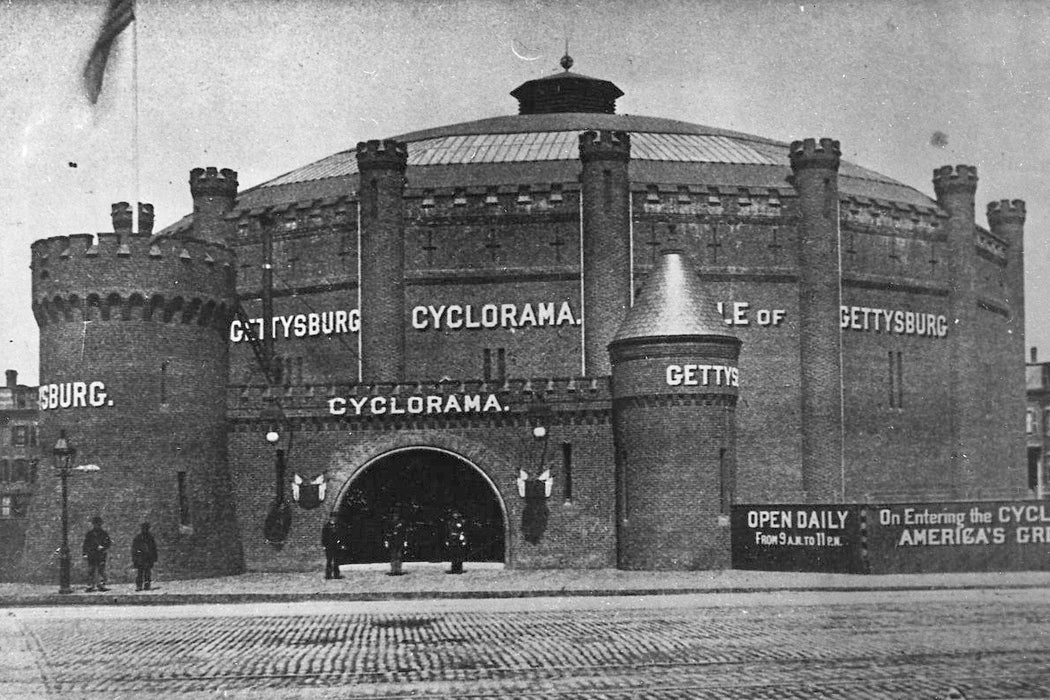In the fall of 1886, New Yorkers were transported to the Battle of Gettysburg. That is to say, they flocked to a circular structure in downtown Brooklyn. The inside walls of the curious room were covered with a 360-degree painting, on which soldiers charged and cannons fired. As Scientific American described at the time, the floorboards were covered with sod and “real trees, evergreens and others, with shrubbery, portions of fences, and the like are set about, and tufts of grass, wheat, and similar things, lend their aid to fill up the scene.” Skylights illuminated the canvas and props while leaving the spectator area dark, and mannequins were posed alongside the painted scene. So convincing were these dummies that the police got called one evening to stop a robbery and apprehended two fake soldiers.
This immersive installation, known as a cyclorama, was one of several that popped up around the United States and Europe in the nineteenth century. Civil War scenes were popular, but so were Niagara Falls, the Biblical Crucifixion, the Chicago Fire of 1871, and the Battle of Waterloo. They were the virtual reality of their time, combining art, lighting, architecture, and installations to convey viewers to exotic locales or the recent and distant past.
Irish painter Robert Barker is often credited with introducing what he described as a “picture without boundaries” in 1787, debuting his invention with a cylindrical panorama of Edinburgh. Cycloramas arrived in the United States by the end of the 1800s, and took off in the mid-nineteenth century. Because they required a specially-designed circular building, they tended to be long-term exhibitions. “Typically, a cyclorama stayed at one place until the local public lost interest in it and ticket sales dropped,” explains scholar Charles G. Markantes in Military Images. “Once the novelty wore off, some owners went bankrupt and were forced to abandon their paintings. Cycloramas remained viable attractions only where the location itself continued to attract visitors, such as the battlefield of Gettysburg or Atlanta.”

Similar to nineteenth-century moving panoramas, which involved incredibly long paintings that moved like filmstrips, the cyclorama was a pre-cinema mode of entertainment. With the arrival of cinema in the early 1900s, ticket sales to the cycloramas plummeted. Many disappeared or were destroyed. “Paper-bound booklets sold to visitors when the paintings were on exhibition carried representations of the works, but the images were of poor quality, and only a handful of the booklets have survived,” writes academic Michael Cunningham in Military Images.
Most of the hundreds of cycloramas that were produced vanished with little documentation. On February 22nd, 2019, however, one historic cyclorama is returning to public display. The restored Atlanta Cyclorama will be on view at the Atlanta History Center following a relocation from its previous home in the city’s Grant Park. Measuring 42 feet high and 358 feet long, it is among the largest oil paintings in the world, and depicts the 1864 Battle of Atlanta.
Get Our Newsletter
As Jack Hitt recently wrote in Smithsonian Magazine, this new cyclorama is not just a vivid visualization of that engagement, but a physical chronicle of what people chose to remember and forget about the Civil War. It debuted in Minneapolis in 1886, where Northerners appreciated its representation of a Union victory, one depicted with details based on the artists’ interviews with veterans and visits to the battlefield. When it was acquired by a Georgian named Paul Atkinson in the late 1800s, he used a bit of paint to turn a group of defeated Confederates into Union soldiers. Even a mannequin of Clark Gable joined the display in the twentieth century, as it continued to be reinterpreted and altered to reflect current tastes.
The Atlanta Cyclorama that makes its return next year will be joined by exhibitions that contextualize this past. Visitors will witness a restored experience, where art and design come together to take viewers out of their world and into the midst of a war.







